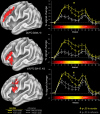Dorsolateral prefrontal cortex promotes long-term memory formation through its role in working memory organization
- PMID: 16421311
- PMCID: PMC6675388
- DOI: 10.1523/JNEUROSCI.2353-05.2006
Dorsolateral prefrontal cortex promotes long-term memory formation through its role in working memory organization
Abstract
Results from neuroimaging studies have shown that the dorsolateral prefrontal cortex (DLPFC) implements processes critical for organizing items in working memory (WM). Based on its role in WM, we hypothesized that the DLPFC should contribute to long-term memory (LTM) formation by strengthening associations among items that are organized in WM. We conducted an event-related functional magnetic resonance imaging (fMRI) study to test this hypothesis by investigating prefrontal activity during performance of two different WM tasks: on "rehearse" trials, participants actively maintained triplets of words during a brief delay, whereas on "reorder" trials, participants actively organized each triplet during the delay. After scanning, subjects performed an LTM test on words presented during both WM conditions. Behavioral results showed that WM processing in the reorder condition enhanced LTM by strengthening inter-item associations. fMRI results showed that DLPFC activity specifically during reorder trials was predictive of subsequent LTM. In contrast, activity in the posterior ventrolateral prefrontal cortex was predictive of LTM for words studied on both reorder and rehearse trials. These results support the view that the DLPFC contributes to LTM formation through its role in organization of information in WM.
Figures





References
-
- Aguirre GK, Zarahn E, D'Esposito M (1997) Empirical analyses of BOLD fMRI statistics. II. Spatially smoothed data collected under null-hypothesis and experimental conditions. NeuroImage 5: 199–212. - PubMed
-
- Baker JT, Sanders AL, Maccotta L, Buckner RL (2001) Neural correlates of verbal memory encoding during semantic and structural processing tasks. NeuroReport 12: 1251–1256. - PubMed
-
- Barde LH, Thompson-Schill SL (2002) Models of functional organization of the lateral prefrontal cortex in verbal working memory: evidence in favor of the process model. J Cogn Neurosci 14: 1054–1063. - PubMed
-
- Bor D, Cumming N, Scott CE, Owen AM (2004) Prefrontal cortical involvement in verbal encoding strategies. Eur J Neurosci 19: 3365–3370. - PubMed
-
- Bower GH (1970) Imagery as a relational organizer in associative learning. J Verb Learn Verb Behav 9: 529–533.
Publication types
MeSH terms
Grants and funding
LinkOut - more resources
Full Text Sources
Medical
